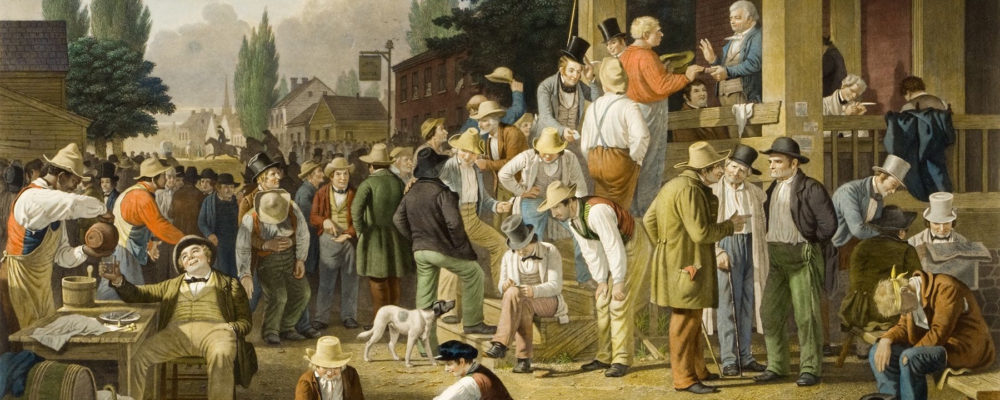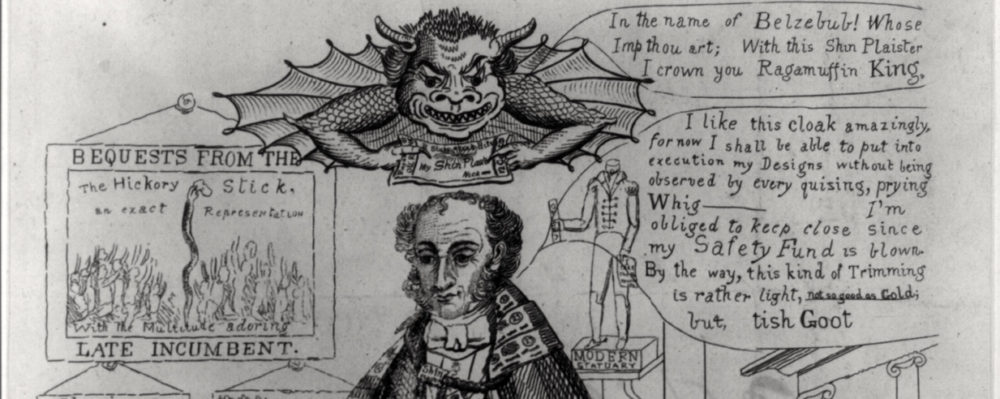Introduction
Today, most Americans think democracy is a good thing. We tend to assume the nation’s early political leaders believed the same. Wasn’t the American Revolution a victory for democratic principles? For many of the Founders, however, the answer was no. American democracy did not flow smoothly after the American Revolution. It had to be fought for again and again. The 1830s were dominated by battles over democracy as a new populist Democratic Party led by Andrew Jackson repealed property restrictions on voting. Universal white male suffrage was the rallying cry of the era. This expansion of the franchise occurred at the expense of black Americans, however, as race came to replace class as barrier to democratic participation. These sources explore the fights over democracy at the heart of the era.
Documents
Southerners dominated the highest federal offices for the first decades of the United States, as Virginians held the Presidency for nation’s first thirty-two of the first thirty-six years. Northerners resented this dominance and sectional tensions simmered until they threatened to boil over in 1820 when James Tallmadge included the below amendment to Missouri’s application for statehood. Included below is Tallmadge’s amendment; the final act which settled the crisis, at least temporarily; and a private letter from Thomas Jefferson illustrating his reaction to the crisis.
Many poor white men gained voting rights, also known as suffrage, for the first time in the 1830s. These changes in American democracy did not take place without conflict. Voting rights in Rhode Island only changed after poor Rhode Islanders raised a militia and threatened violence. Below is the proposal of many of the men who seven years later took up arms to right for voting rights.
The expansion of voting rights to poor white men brought a loss of voting rights for Black men. Race, rather than class, quickly became the most important social distinction in the United States. Some wealthy Black men, like James Forten and Robert Purvis of Pennsylvania, lost voting rights that they previously enjoyed. In this document, Philadelphians protest the loss of their voting rights.
President Andrew Jackson, like Thomas Jefferson before him, was highly suspicious of the Bank of the United States. He blamed the bank for the Panic of 1819 and for corrupting politics with too much money. After congress renewed the bank charter, Jackson vetoed the bill. The following was the message he gave to congress after issuing his veto. Jackson’s decision was controversial. Some Americans accused him of acting like a dictator to redistribute wealth. Others saw the act as an attack on a corrupt system that only favored the rich.
Frederick Douglass was born into slavery in Talbot County, Maryland in 1818. He was separated from his mother in infancy and lived with his grandmother until he was separated from her as well at age seven. After several attempts, he finally successfully escape slavery in 1838. He became one of the most influential abolitionist speakers and before a crowd of white abolitionists in 1852, he delivered this, one of the greatest abolitionist speeches.
In 1834 anti-Catholic rioters burned the Ursuline Convent in Charestown, Massachusetts. In 1835, Rebecca Reed published a memoir about her time staying at the convent. Prior to its publication, rumors existed about Reed’s experience that may have motivated the arsonists. In these documents, we read excerpts from Reed’s account and the response from the convent’s Mother Superior Mary St. George.
Irish immigrants in the early nineteenth century filled jobs created by the Market Revolution. Their arrival provided an important source of labor for a growing economy, but many Americans worried about the influence of these arrivals. Samuel Morse, an inventor who contributed to the development of the telegraph and Morse Code, feared that Irish immigrants represented the front line of a Catholic conspiracy to destroy the United States.
Media
Beginning in the late 1840s, George Caleb Bingham created a series of paintings illustrating American democracy. He was drawn to the energy and near-chaos of speeches, rallies, election days, public announcements of voting results and more. Prior to painting this work, Bingham himself ran for state office in Missouri as a Whig. Here he shows the tumult of a county election day. Children play games, drunkards raise their glass (while political operatives drag inebriated men to the poll), citizens carefully debate the issues, while others study the newspaper. Art historians argue whether Bingham is celebrating or mocking American democracy.
This caricature of President Martin Van Buren cloaked in worthless bank notes was created during the Panic of 1837. The artist mocks Van Buren and the policies of his predecessor, Andrew Jackson. The cartoon includes mentions to Jackson’s “Specie Circular,” an order that government officials only accept gold or silver as payment for land and Van Buren’s “Safety Fund,” a program designed to offset the damage of bank failures. A document labeled “Indian claims” also refers to Jackson’s policy of Indian Removal. These and other subtle details reveal the anxieties of economic collapse and the policy differences between Democrats and Whigs.


